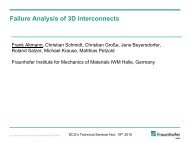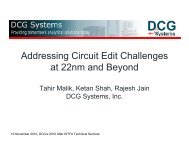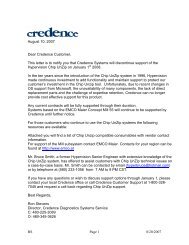Application of Laser Stimulation Techniques to ... - DCG Systems
Application of Laser Stimulation Techniques to ... - DCG Systems
Application of Laser Stimulation Techniques to ... - DCG Systems
You also want an ePaper? Increase the reach of your titles
YUMPU automatically turns print PDFs into web optimized ePapers that Google loves.
<strong>Application</strong> <strong>of</strong> <strong>Laser</strong> <strong>Stimulation</strong> <strong>Techniques</strong><strong>to</strong> Analog ICs DebugMagdalena SIENKIEWICZNovember 19 th 2009<strong>DCG</strong> <strong>Systems</strong> Seminar, Fremont
PLAN• Background- Introduction- Static versus dynamic analysis- Digital versus analog circuits analysis• xVM – setup <strong>to</strong> map different parameters• Methodology <strong>to</strong> support laser localization <strong>of</strong> “S<strong>of</strong>t Defects” onanalog and mixed-mode ICs & case study• OBIRCh amplifier used for dynamic failure localization2
PLAN• Background- Introduction- Static versus dynamic analysis- Digital versus analog circuits analysis• xVM – setup <strong>to</strong> map different parameters• Methodology <strong>to</strong> support laser localization <strong>of</strong> “S<strong>of</strong>t Defects” onanalog and mixed-mode ICs & case study• OBIRCh amplifier used for dynamic failure localization3
Introduction (1/2)Failure localization by using laser stimulation techniquesDevice is in its electrical failingconfiguration<strong>Laser</strong> beam scans the DUT inducingthermal or pho<strong>to</strong>electric phenomenonCorrelation between laser position &device electrical response<strong>Laser</strong> source<strong>Laser</strong>ScanningMicroscopelaserbeamDUT*Mapping <strong>of</strong> the sensitive/failing areasDUT: Device Under Test4
Introduction (2/2)Induced phenomenonThermal• <strong>Laser</strong> λ = 1340nm• Conductive elements heating(ΔR, Seebeck Effect)• Current / Voltage variation• Short circuit localization,insula<strong>to</strong>r defects etc.Pho<strong>to</strong>electric• <strong>Laser</strong> λ = 1064nm• Electron - hole pair generationin Si substrate• Pho<strong>to</strong>current generation• Junctions defects localization,opens etc.OBIRCh, TIVA, SEI;RIL, SDL…OBIC, LIVA;LADA…5
Static versus dynamicStatic• Device is powered on and haltedat a steady state• <strong>Laser</strong> beam can be continuous,pulsed or modulated• <strong>Laser</strong> is scanning above alwaysfailing DUT, variation in electricalsignal (I, V) is measuredDynamic• Device is permanently running(test pattern, AC signal)• Continuous, pulsed or modulatedlaser is slowly scanning the DUT• <strong>Laser</strong> beam is fixed at the sameposition during at least one cycle• <strong>Laser</strong> scan modifies pass/failstate (s<strong>of</strong>t defect) or inducesparametric changes (timing, f, V)1987 1993 1999 2001 2002 2003 2005 2007OBIC(Wilson)OBIRCH(Nikawa)TIVA/SEI(Cole)RIL(Cole)SDL(Bruce)LADA DVM PVM(Rowlette)(Sanchez)(Sanchez)6
Digital versus analog (1/3)Moni<strong>to</strong>red parametersDigitalAnalog/Mixed-Mode∆τ0/1∆τ∆V0/1 level output signalsOnly 2 parameters analyzed:• 0/1 logic level,• time variation (∆τ)Multi level output signalsMore parameters <strong>to</strong> analyze:• amplitude,• RMS,• SNR,• frequency,• time variation (∆τ),• FFT,• …7
Digital versus analog (2/3)<strong>Laser</strong> mappingDigital measurementAnalog measurement2D image3D imageK.Sanchez, PhD report« Developpement et application de techniques par stimulationdynamique laser pour la localisation de défauts et le diagnostic decircuits intégrés »8
Digital versus analog (3/3)<strong>Laser</strong> mapping: analog & MM• Dynamic analysis ⇒ Multiple functions areexecutedPVM image• Intrinsic sensitivity <strong>of</strong> the analog devices ismuch stronger than in case <strong>of</strong> digital ICs• Different sensitivity levels in one mapping• The most sensitive device is not necessarilythe failing device• The use <strong>of</strong> digital oriented techniques doesnot necessarily allow failure localizationParametric techniques needed <strong>to</strong>analyze analog/MM devicesMixed Mode Good RF ICPower Amplifier driverblockPVM: Phase Variation Mapping9
PLAN• Background- Introduction- Static versus dynamic analysis- Digital versus analog circuits analysis• xVM – setup <strong>to</strong> map different parameters• Methodology <strong>to</strong> support laser localization <strong>of</strong> “S<strong>of</strong>t Defects” onanalog and mixed-mode ICs & case study• OBIRCh amplifier used for dynamic failure localization10
xVM techniquesxVM setup (1/2)λ=1064nmor λ=1340nm<strong>Laser</strong>BeamImage processing &Control unitCorrelation: laser position(x,y) & DUT outputINsOUTTAC*Sensitive/failingzone mappingPSD**…*TAC: Time <strong>to</strong> Amplitude Converter**PSD: Phase Sensitive Detec<strong>to</strong>r11
xVM techniquesSetupxVM setup (2/2)<strong>Laser</strong>BeamImage processing &Control unitCorrelation: laser position(x,y) & DUT outputINsOUTCH1C++ applicationAUX OUTOscilloscope(measurement &data processing)Sensitive/failing zone mapping• t RISE , t FALL , duty cycle, time delay• SNR, RMS• frequency, jitter, FFT…12
xVM techniquesAnalyzed Setup device & setup Commercial, good device Operational amplifierset in a high gain configuration Bias condition: V + = 1.5V, V - = -1.5V V IN = 50mV p-p sinusoidal signal at 1kHz2.5x lensP=0.66mWCW, λ=1064nmPixel time=7ms13
Results: Various parameter mappingxVM techniquesRMSt RISE_20-80%PowerSpectrum MAXPowerSpectrum NOISE14
xVM techniquesExtraction <strong>of</strong> a low signal variation (1/2)p=<strong>Laser</strong> BeamINs' 1AUX OUTOUTCH1( p ) 2v− p_ RAWv _ No _ LSImage processing &Control unitCorrelation: laserposition (x,y) & DUToutputOscilloscope<strong>Application</strong> runMeasurement(Data processing)Algorithm executionSend data <strong>to</strong>AUX OUTSensitive/failing zonemapping15
Results: Extraction <strong>of</strong> a low signal variation (2/2)Power Spectrum MAXxVM techniquesRaw dataData processed in real time16
PLAN• Background- Introduction- Static versus dynamic analysis- Digital versus analog circuits analysis• xVM – setup <strong>to</strong> map different parameters• Methodology <strong>to</strong> support laser localization <strong>of</strong> “S<strong>of</strong>t Defects” onanalog and mixed-mode ICs & case study• OBIRCh amplifier used for dynamic failure localization17
New methodology• Understand the DLS complex signatures in dynamicallyworking Analog/Mixed-Mode ICsDevelop a new methodologyTLSPLS<strong>Laser</strong> <strong>Stimulation</strong> mapping(experiment)CORRELATIONElectrical simulation <strong>of</strong> thephenomenon induced by the laser18
PVM case study (1/4)S<strong>of</strong>t defect localization• Mixed-mode au<strong>to</strong>motive IC under development• 0.25µm technology• 3 metal layers + 1 copper layerFunctional failure at high temperature120100PVM (PhaseVariationMapping)Electricalsimulations~20.000 transis<strong>to</strong>rs Electrical diagnosis Failure localization19
PVM case study (2/4)PVM principleNIR laser beamINREFOUTVARIATIONphaseamplitudeduty cycle• REF & OUT signals are synchronized with a fixed ∆phase• By multiplying these signals we can detect phase, amplitudeor duty cycle variation (PSD, Lock-in)20
PVM case study (3/4)<strong>Laser</strong> mapping (PVM, 1340nm) with Vbat variation1 sub-block wasfound sensitive21
PVM case study (4/4)Backside DTLS localizationImage PVMPattern+PVMLayout & schematic analysisAdditional electrical simulationAmbient temp High tempDesign issue identified22
PLAN• Background- Introduction- Static versus dynamic analysis- Digital versus analog circuits analysis• xVM – setup <strong>to</strong> map different parameters• Methodology <strong>to</strong> support laser localization <strong>of</strong> “S<strong>of</strong>t Defects” onanalog and mixed-mode ICs & case study• OBIRCh amplifier used for dynamic failure localization23
OBIRCh amplifier used for dynamic analysisCase study: Device & timing defect description• Au<strong>to</strong>motive, Mixed-Mode IC• 0.8µm technologyOUT signal switched <strong>of</strong>f with an anomalous delay ∆τINT [°C] ↑ ⇒ ∆τ ↓OUT∆τGOOD PARTOUTOUT∆τFAIL PART(T1)FAIL PART(T2)Thermal sensitivedefect24
OBIRCh amplifier used for dynamic analysisCase study: Electrical setup• Thermal sensitivity ⇒ 1.3µm laser beam• ∆τ (T) variation ⇒ cycling <strong>of</strong> the electrical input signal ⇒duty cycle observation1.3µm laser source<strong>Laser</strong> <strong>Stimulation</strong>MicroscopeSignal & Imageprocessing SystemControl SystemV INI OUTV OUTDUTINOUTCurrentProbe Head∆VOBIRChamplifierNo synchronization betweenlaser displacement & DUT OUT25
OBIRCh amplifier used for dynamic analysisResults by using OBIRCh amplifierLow magnificationHigh magnificationTLS mappingTLS mappingTLS mapping+Pattern26
OBIRCh amplifier used for dynamic analysisOBIRCh amplifier localizationDeprocessingGood partN regionFail partN regionN implant <strong>of</strong> thenMOS transis<strong>to</strong>rs wasmasked over severalmicronsP regionP region27
DUT outputOBIRCh amplifier used for dynamic analysisTechnique principle & experiment (1/3)Experiment setupSignalgenera<strong>to</strong>r0V-1V/10kHzR=10kΩ∆VOBIRChamplifier(TIVA mode)Visualization <strong>of</strong> the electrical signal on the image12 pixelsTLS imageNo synchronization betweenlaser displacement & DUT output<strong>Laser</strong> beamdisplacement28
OBIRCh amplifier used for dynamic analysisTechnique principle & experiment (2/3)TLS images (1 frame)Duty cycle 10% 50% 90%29
OBIRCh amplifier used for dynamic analysisTechnique principle & experiment (3/3)No synchronization between laser displacement & DUT outputImage integration = averagingDUT output4 pixels1 frame 2 frame+ =TLS images integration resultsDuty cycle90%50%10%30
Any questions?















